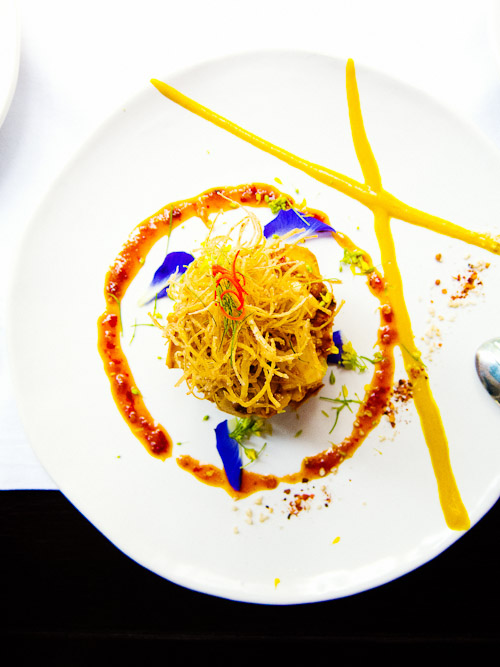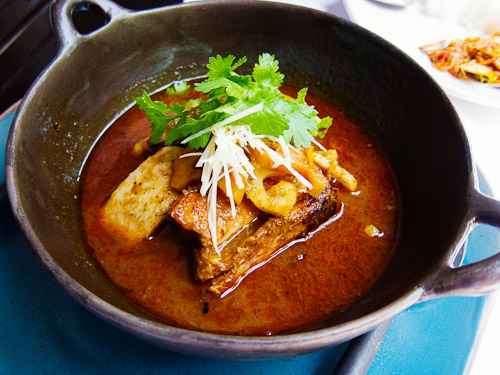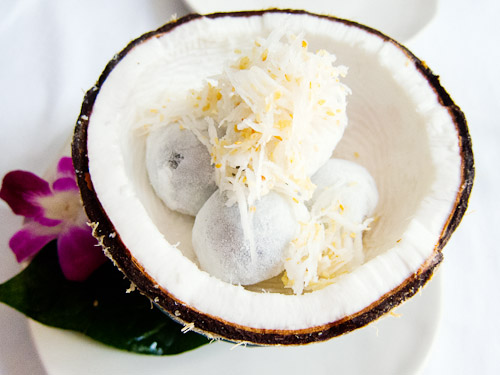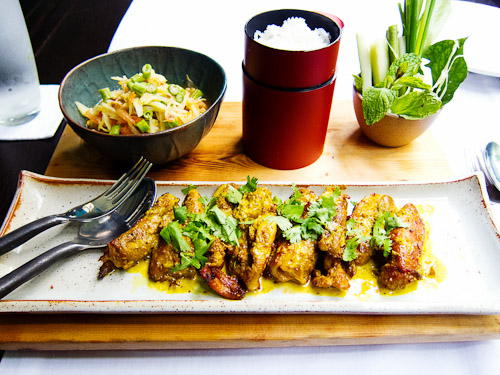 Issaya Siamese club is the first domestic outlet serving Thai food of Bangkok-born chef, Ian Kittichai. As the story goes, Chef Ian started cooking as a child, selling food from a cart along the streets of Bangkok, before eventually going on to helm the Four Seasons Bangkok, and later, Kittichai, in New York City.
Issaya Siamese club is the first domestic outlet serving Thai food of Bangkok-born chef, Ian Kittichai. As the story goes, Chef Ian started cooking as a child, selling food from a cart along the streets of Bangkok, before eventually going on to helm the Four Seasons Bangkok, and later, Kittichai, in New York City.
His most recent restaurant (Issaya) is housed in a charming 1920s-era villa that has been playfully designed by a Danish interior designer. There's a small organic garden out back, lots of lounge-like cozy corners (the Siamese Club part) and in the evenings, lawn seating on comfy-looking cloth chairs.
The restaurant's relatively short menu, referred to as the chef's Childhood Menu, claims to be a collection of 'Favourite dishes from Chef Ian's Childhood'. A review in local listings mag BK mentioned that one of these dishes is Gaeng hung lay, the restaurant's take on kaeng hang lay, a northern-style curry of pork belly. This might very well be the one Thai dish I've cooked and consumed more than any other, and I was curious to see how the restaurant did it:
Like the dishes that followed it, there seemed to be a distinct emphasis on presentation, and by Thai standards at least, serves were huge. The hang lay had the requisite pork belly and hints of dried spice, but these were nearly lost in the curry's overwhelming richness and oiliness. Kaeng hang lay is indeed a rich and oily dish, but usually this is countered by the addition of a few tablespoons of tart tamarind extract, as well as acidic slivers of ginger and small cloves of garlic. Instead, Issaya's version was served with a large chunk of taro and a couple slices of lotus root. These additions are novel (although in Mae Hong Son they do a dish called aloo hang lay, hang lay served with potatoes), yet did little to bring balance to the dish, and instead seemed to make it even heavier.
The waiter recommended the Chili glazed baby back ribs:
which arrived on a smoking Thai-style grill. They were smokey, crispy and tender, but despite Asian-inspired ingredients in the glaze, the dish had more in common with American-style barbecue than anything with origins in Southeast Asia. It was a satisfying -- if somewhat out of place -- dish, but was this really something from the chef's childhood in Bangkok?
In an effort to counter the meatiness, we ordered banana blossom salad (pictured at the top of this post). I didn't even recognise the dish when it arrived, which wouldn't be so bad if I hadn't also failed to recognise its flavours. The salad lacked that crucial intersection of astringency, sweetness, spiciness and coconut milk creaminess, and like the other dishes, seemed to be drowning in an overbearing sauce.
For dessert, we chose the restaurant's take on khanom kho, a Thai sweet I've encountered previously in the southern Thai provinces of Songkhla and Pattani. The traditional version of the dish takes the form of tiny and almost impossibly light pillows of dough enveloping a crunchy core of sugarcane. Issaya's version took the form of large and rather tough Japanese-style moji encasing sesame ice cream:
Again, the presentation was unique, and on the surface at least, the dish sort of resembled khanom kho, but given the wholesale lack of the original dish's defining elements (delicacy, lightness, softness), why not just call it something else?
On a subsequent visit, I tried the restaurant's street food set, which combined grilled chicken, papaya salad and sticky rice:
The grilled chicken took the form of skinless, boneless breast and/or thighs grilled and served in a marinade that combined lots of coconut milk and turmeric, but none of the spicy peppery, savoury flavours of coriander root, white pepper garlic or even salt -- ingredients one would usually encounter in this dish. It seemed more like a clumsy stab at Malaysian food than any Thai street food I'd ever encountered. The papaya salad was unexceptional, and because the restaurant was out of sticky rice, I was given regular rice.
Both experiences were underwhelming, but perhaps the fault was in my ordering? On my first visit, and following the waiter's suggestion, we ended up with three rather meaty and saucy dishes -- hardly a balanced Thai meal. But after a second visit, I suspect that my ultimate mistake was in expecting Thai food. Given Chef Ian's experience and success in the US, the emphasis on presentation, the huge serves, and the general meatiness and sauciness, I couldn't help but wonder, Could Issaya Siamese Club be an example of a chef bringing Thai-American restaurant food to Bangkok?
Issaya Siamese Club 4 Th Sri Aksorn, Bangkok 02 672 9040 11:30am-3pm, 6pm-midnight
View Thai Eats in a larger map















